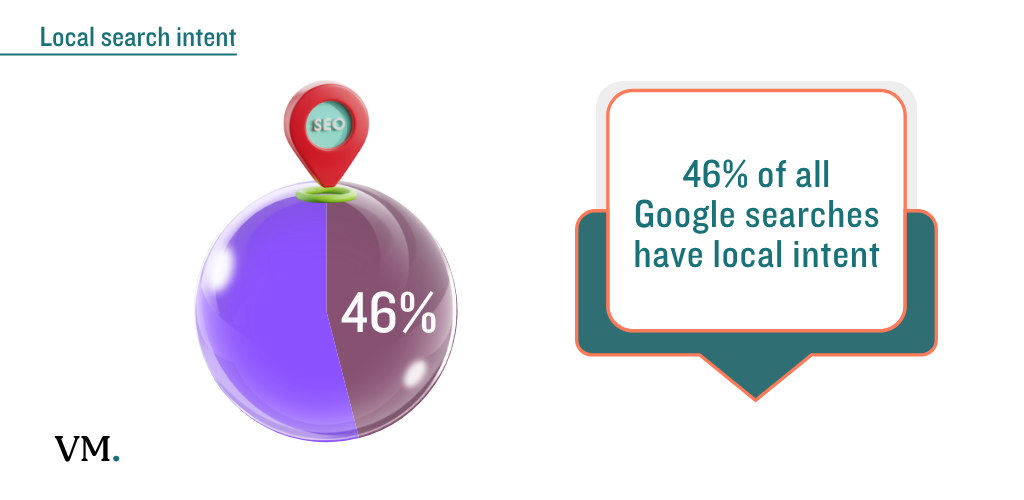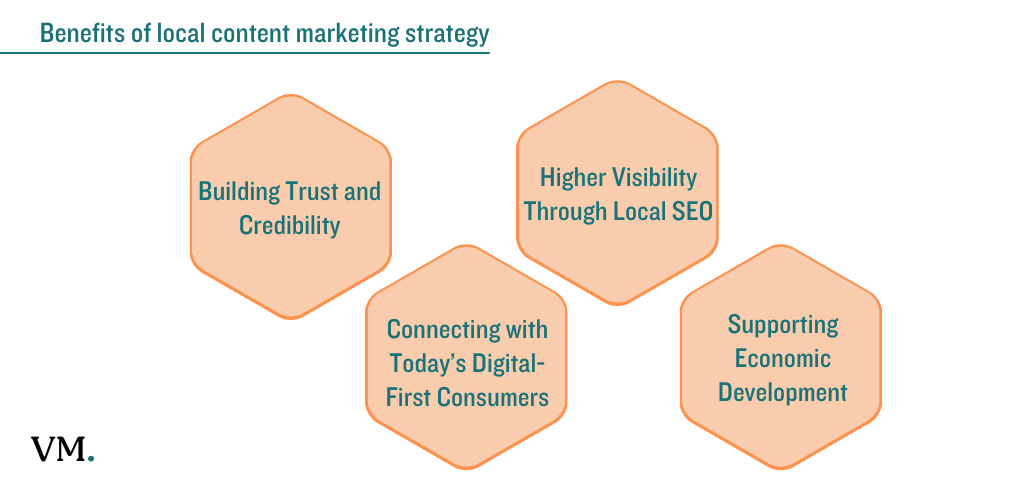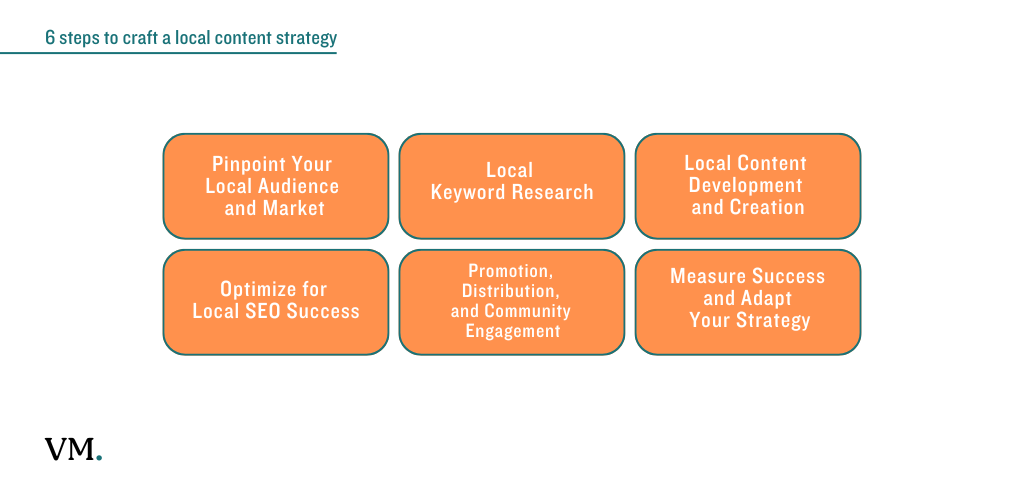As a local business owner, you know you can’t rely on foot traffic and word-of-mouth alone. You need to reach customers online. According to recent local SEO statistics, 46% of all Google searches have local intent. Local businesses face unique challenges in building a successful online presence.
This is where a strong local content strategy comes in, a powerful tool for sustainable growth in your local market.
Creating content that resonates with your local community isn’t just about casting a wide net. It’s about becoming a trusted resource that local businesses can learn from and customers can rely on.
An effective local content marketing strategy doesn’t just aim for visibility; it attracts real people searching for what local businesses offer, right in their neighborhood.

What is a Local Content Strategy?
Simply put, a local content strategy means shaping your content, blog posts, social media, videos, around the needs and interests of your local audience. This approach to local content development focuses on creating content that speaks directly to your local market.
Think hyperlocal, like a spotlight focused directly on your local community. Whether you’re in retail, services, or even industries like the oil and gas sector, local content helps establish your business as an authority in your local area.
Take, for example, Seed, a probiotics brand. Their digital marketing strategy involves an intense focus on education through local content.
They create opportunities to position themselves as authoritative experts in gut health, using content strategy to support local engagement and build trust.
Reasons Why Local Content Strategy is Essential for Success
A 2019 study by Content Marketing Institute found that almost 76% of organizations planned to increase their approach to creating content. This shows local businesses and international companies alike are catching on to its importance.
For local businesses, implementing a local content marketing strategy delivers value beyond just driving website visits.
Here’s why this matters now more than ever:
Building Trust and Credibility
By offering valuable local content, you’re establishing yourself as a familiar face in the local community. People tend to trust local businesses that clearly understand their needs. This approach helps create opportunities for meaningful connections.
Tools like Google Trends can help uncover the most relevant local keywords.
Higher Visibility Through Local SEO
Google prioritizes local content that caters to local search intent. Implementing local SEO strategies puts local businesses on the map. When you focus on creating content with local keywords (think “best coffee shop Denver” or “Denver bike repair”), you establish a stronger presence in search results.
Connecting with Today’s Digital-First Consumers
An Intuit survey revealed that 70% of Americans prefer shopping locally online. Local businesses can leverage this by promoting local event sponsorships and specials through their digital marketing efforts. This local content approach bridges the gap between your digital presence and physical location.
Supporting Economic Development
When local businesses invest locally in local content creation, they contribute to job creation and economic development. This sustainable growth model helps build stronger communities while supporting local industries.

How to Craft a Successful Local Content Strategy: 6 Key Steps
Creating a local content strategy requires careful planning and successful implementation.
Let’s explore the essential steps:
Step 1: Pinpoint Your Local Audience and Market
Understanding your niche and your target audience at the local level is crucial for local businesses. A deeper understanding of your local market leads to more engaging local content.
Begin with research into their needs, interests, and the platforms they use.
Engage directly with customers through surveys or social media polls. Use their feedback to support local content development and establish connections with your local community.
Step 2: Local Keyword Research
Keywords are essential for your local content marketing strategy. They guide customers toward local businesses like yours. Platforms like Semrush or Ahrefs are great resources for research.
Compare these two platforms in this blog “Semrush vs Ahrefs“
Focus on local SEO keywords that your local audience uses when searching for services. Incorporate these throughout your blog posts and website to create opportunities for visibility.
Step 3: Local Content Development and Creation
With keyword research complete, start creating content that provides value to your local community. Successful local content addresses specific needs of your local market while establishing your expertise.
Types of local content to create:
| Type of Local Content | Example | Benefits for Local Businesses |
| Blog Posts | Top 10 Hiking Trails near Denver | Drives traffic for d2c brands, establishes local expertise |
| Videos | Behind the Scenes at Our Local Business | Builds connection, humanizes the brand |
| Social Media | Highlighting local events and customer stories | Fosters interaction, immediate engagement |
| Guides | Complete Guide to Local Services in Miami | Positions as local authority, provides value |
Use HubSpot’s content strategy template to organize your local content calendar.
Step 4: Optimize for Local SEO Success
Local SEO is crucial for local businesses looking to establish online presence.
Your Google Business Profile (GBP) is your best friend. Learn how to optimize your GBP listing to maximize local visibility.
Ensure your listing includes:
- Accurate business information
- Regular updates about local events
- Photos showcasing your services
- Responses to customer reviews
- Local content that highlights your involvement in the local community
This digital marketing approach signals to Google that your business actively serves the local market.
Step 5: Promotion, Distribution, and Community Engagement
Creating content is just the beginning.
Local D2C businesses must actively promote their local content across multiple channels:
- Share blog posts in local Facebook groups
- Partner with other local businesses for cross-promotion
- Participate in local events to gather content ideas
- Use email newsletters to support local engagement
- Collaborate with local industries and educational institutions
They have to build loyalty and a community plus always be innovative.
Step 6: Measure Success and Adapt Your Strategy
Successful implementation of a local content marketing strategy requires ongoing measurement.
Track metrics like:
- Local search rankings (local SEO performance)
- Engagement from your local audience
- Conversion rates from local content
- Growth in local community connections

What I’ve Tried (and What Worked)
I’ve tried to understand, first of all, the local business and its niche, as well as its respective customers. For me, it was essential to understand the products, what the local company is selling, and how the customer can take the best advantage of these products.
With these first actions, I’ve built the knowledge to understand the local business.
The next step was to work closely with the business owner or the head of marketing to plan the first content blogs.
This step brought me close to the content idea and what we can write in the beginning. Most local businesses, from my experience, have never written any blog article and don’t have the time to write articles or manage them.
I sat down with the company owner, and we reviewed his latest project and its completion. Through that, we developed the first content idea.
For example, an local D2C e-commerce business that sold local honey had no blog articles, so I developed the first blog article with the CEO of this company, targeting the keyword “honey to buy,” and we published our first article.
Later, I showed him what was written, and he provided me with all the necessary information for this blog article.
By the end of the week, we had our first written blog.
Advanced Local Content Strategies for Sustainable Growth
Building Partnerships with Local Suppliers and Businesses
Local businesses can create opportunities through joint ventures and partnerships.
This approach to local content development helps establish stronger connections while supporting local economic development.
Leveraging Local Events for Content Creation
Local events provide excellent opportunities for creating content. Whether it’s sponsoring community gatherings or participating in local festivals, these activities generate authentic local content that resonates with your target audience.
Developing Educational Content for Local Skills Development
Partner with educational institutions to create content that supports local training and capacity development. This type of local content positions your business as invested in the local community’s growth.
For additional insights, explore Search Engine Journal’s guide to local content strategy.
The Role of Digital Marketing in Local Content Success
Digital marketing amplifies your local content strategy.
By combining local SEO, social media, and content marketing, local businesses can establish a comprehensive online presence that drives success.
Key Digital Marketing Tactics for Local Businesses:
- Regular blog posts targeting local keywords
- Social media campaigns highlighting local events
- Email marketing to your local audience
- Video content showcasing local expertise
- Local partnership content with link building with other niche relevant local businesses
Common Challenges and Solutions
Challenge 1: Limited Resources
Many local businesses struggle with creating content consistently.
Solution: Focus on quality over quantity. Even one well-crafted blog post per week can establish your presence.
Challenge 2: Standing Out Among Competitors
With many local businesses implementing content strategies, differentiation is key.
Solution: Focus on unique local content that only your business can provide, insider knowledge, local expertise, and authentic community connections.
Challenge 3: Measuring ROI
Tracking the success of your local content marketing strategy can be challenging.
Solution: Set clear goals for job creation, customer acquisition, and community engagement. Use analytics tools to measure local SEO performance and audience growth.
Summary: Building Success Through Local Content
A properly designed local content strategy serves as a powerful tool for local businesses seeking sustainable growth. By focusing on creating content opportunities that serves your local community, you establish trust, improve local SEO rankings, and create opportunities for meaningful connections.
Remember: your local content is more than just words on a screen; it’s an invitation to connect with your local market in meaningful ways.
In an era of endless choice, that local connection helps local businesses build lasting customer relationships and support local economic development.
For more additional insights, explore my All Tools section to find best local content tools.
FAQ
What is a local content strategy?
A local content strategy focuses on creating valuable and relevant content—such as blog posts, videos, social media updates, and guides—tailored specifically to the interests and needs of your local audience. The goal is to position your business as a trustworthy local authority and attract local customers searching for products or services in your area.
Why is a local content strategy essential for local business success?
-
Trust & Credibility: Providing useful local information builds trust and makes your business a familiar, reliable presence in the community.
-
Local Visibility: Content crafted with local intent ranks higher in local search results, helping more local customers find you.
-
Modern Consumer Habits: 70% of Americans prefer shopping locally online, so your digital presence matters more than ever.
-
Economic Development: Invested local content benefits your business and the broader community by encouraging spending and supporting local jobs.
-
Proven Results: 46% of all Google searches have local intent, and 88% of users who search for a local business on their smartphone visit a related store within a week
What are the most important local SEO ranking factors?
According to leading studies and marketers, the most important local SEO ranking factors are:
-
For Google’s Local Pack:
-
Main Google Business Profile category
-
Keywords in Google Business Profile title
-
Proximity of business address to the searcher
-
A physical address in the city of search
-
High Google ratings and the number/quality of reviews.
-
-
For local organic (website) rankings:
-
A dedicated page for each service
-
Internal linking across your website
-
Quality/authority of inbound links (backlinks)
-
Relevant keywords in your content and website titles
-
How can I develop a successful local content strategy?
Follow these 6 steps:
-
Pinpoint Your Local Audience: Research your community’s needs, preferences, and online habits.
-
Do Local Keyword Research: Find and use keywords your local customers are searching for.
-
Develop & Create Local Content: Publish blogs, videos, guides, and social content relevant to your area or industry.
-
Optimize for Local SEO: Perfect your Google Business Profile, ensure up-to-date business info, collect reviews, and highlight local involvement.
-
Promote & Engage: Share your content in local groups, partner with other businesses, participate in events, and build community ties.
-
Measure and Adapt: Track search rankings, web traffic, and community engagement to refine your approach.
Do I need advanced tactics to stand out?
Yes. Strategies include:
-
Building partnerships with local suppliers and businesses for co-created content.
-
Leveraging local events as content inspiration and engagement opportunities.
-
Developing educational content with local schools or organizations.
What common challenges do local businesses face with content strategy?
-
Limited resources: Focus on quality, not quantity. Start with one great piece a week.
-
Standing out: Be hyperlocal—share stories and tips unique to your community or business.
-
Measuring ROI: Set clear, trackable goals (rankings, leads, sales, engagement) and use analytics tools to monitor progress
Which platforms are most effective for reaching local customers?
-
Google Search & Maps: 72% and 51% of consumers use these for local business info.
-
Social Media: Instagram, TikTok, and Facebook are especially popular among younger demographics.
-
Business Website: Being found via your official website still builds trust.
-
Yelp, Apple Maps, Bing: Also cited as important channels
What metrics should I use to measure local content strategy success?
-
Local search rankings in Google and Google Maps
-
Website traffic from local keywords
-
Engagement metrics (likes, shares, comments) on local content
-
Conversion rates from local web visitors
-
Growth in online reviews and community partnerships
What is the fastest way to improve my local content results?
-
Make sure your Google Business Profile is complete and accurate—businesses with complete profiles are 2.7x more likely to be seen as reputable and 50% more likely to be considered.
-
Focus on creating content around trending local keywords or events.
-
Seek and respond to customer reviews.
-
Share authentic local stories and consumer experiences.
Share:




